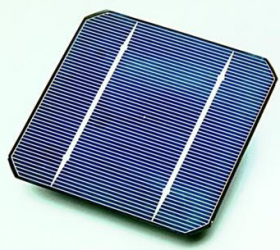June 12, 2009 feature
Using nanoparticles to increase the effiiciency of thin film solar cells

Germany is one of the leading countries when it comes to efforts related to renewable energy sources. Therefore, it is no surprise that the Institute of Condensed Matter and Solid State Optics at Friedrich-Schiller-Universität in Jena, Germany, is a place where scientists are hard at work looking for ways to improve current solar cell technology.
“There is a great desire to make regenerative energies more attractive,” Carsten Rockstuhl, one of the physicists at the Institute, tells PhysOrg.com. “In solar cell technology, it is becoming a matter of interest to improve efficiency without increasing the thickness of the active layer of a solar cell.” Rockstuhl and his colleague at the Institute, Falk Lederer, believe that they may have found a way to increase the absorption of light by solar cells. Their work focuses on using metallic nanodiscs that sustain plasmonic resonances to manage photons, and is explained in Applied Physics Letters: “Photon management by metallic nanodiscs in thin film solar cells.”
Using a simulation, Rockstuhl and Lederer analyzed different scenarios exploring how metallic nanoparticles could be distributed over the surface of a thin film solar cell. The nanoparticles in the simulation increased absorption in the solar cell, and improved the efficiency of the cell integrated over the entire spectral domain by up to 50 percent. “It may not sound like that much,” Rockstuhl says, “but in the world of solar technology, that is a pretty big difference.”
Part of the reason that the simulation shows such promise is that Rockstuhl and Lederer propose matching the absorption spectra of the used nanodiscs to the absorption edge of the silicon solar cell. “Instead of using randomly distributed nanoparticles with different sizes, one may figure out precisely the size and distribution that enhances the absorption in the solar cell the strongest,” Rockstuhl explains. “Controlling the way you spread the nanoparticle over the top of the solar cell can make a difference.”
So far, the setup proposed at the Institute has not been experimentally tested. However, Rockstuhl thinks it might be soon. “Our process should not be too expensive to test and, later, to fabricate. All you have to do is use present technology to create these nanodiscs and apply it to the surface of the solar cell.” For mass production, it would be subsequently possible to use nano-imprint technology to create a kind of stamp to fabricate nanodiscs of a specific size. “It is kind of a breakthrough, in that few people from the solar cell community have thought of improving efficiency by integrating a supplementary structure.”
This practical application is not the only thing that might come out of the model produced by Rockstuhl and Lederer. “This is also attractive in the way it could lead to new research directions, in where different fields of science can learn from each other for the mutual benefit,” Rockstuhl says. “Using our simulation as a kind of blueprint for an experiment could help researchers to advance in the areas of optics and photonics, since they may find a field of application within photovoltaics where their fundamental science oriented research turns out to do some something useful, where it is moreover strongly desired. To increase the solar cell efficiency has to be understood as a major contribution to slow down or even eventually reverse the global warming.”
Rockstuhl continues with his hopes for what their work, which has been supported by the German research council, can accomplish: “And with this work we are certain to put photon management using optical micro- and nano-structures on the agenda, hope that the added value photonics can provide to solar cells is recognized and that it will find its way in commercial solar cells.”
More information: Carsten Rockstuhl and Falk Lederer, “Photon management by metallic nanodiscs in thin film solar cells.” Applied Physics Letters (2009). Available online: link.aip.org/link/?APPLAB/94/213102/1.
Copyright 2009 PhysOrg.com.
All rights reserved. This material may not be published, broadcast, rewritten or redistributed in whole or part without the express written permission of PhysOrg.com.















